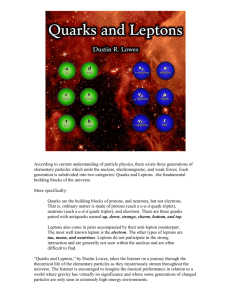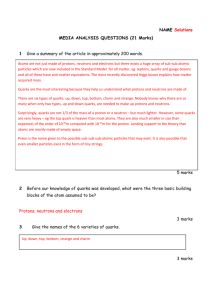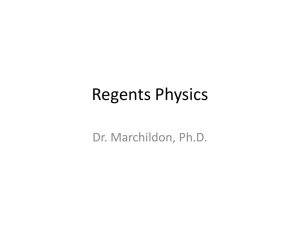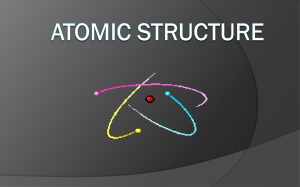Media response assessment task on History of the Atom
advertisement
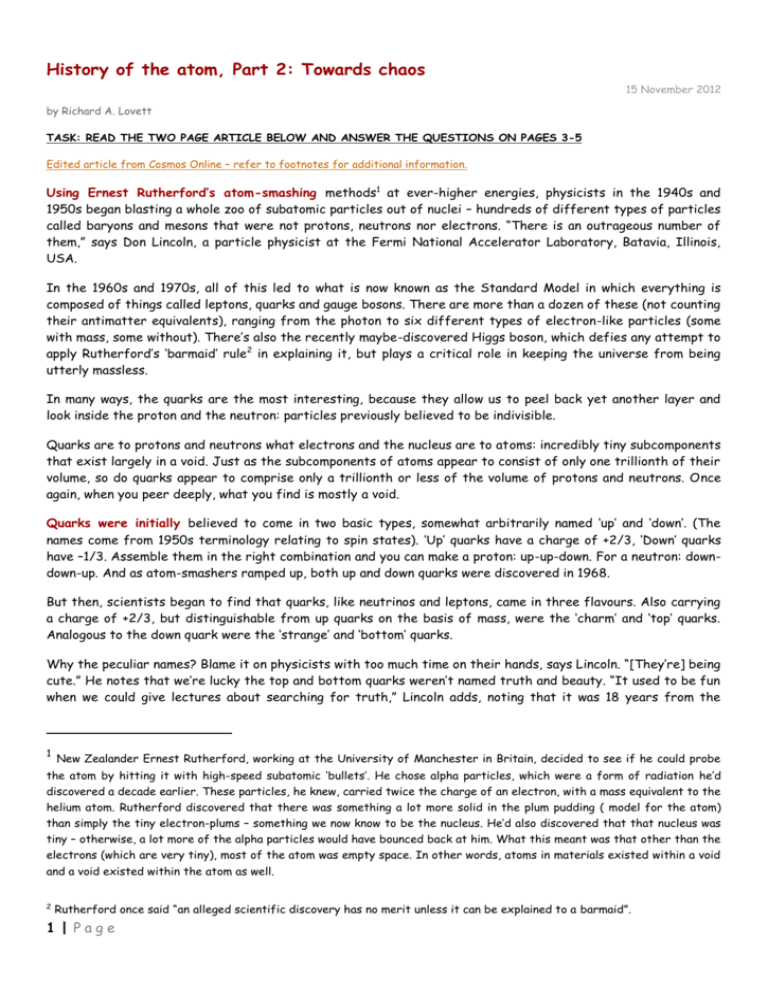
History of the atom, Part 2: Towards chaos 15 November 2012 by Richard A. Lovett TASK: READ THE TWO PAGE ARTICLE BELOW AND ANSWER THE QUESTIONS ON PAGES 3-5 Edited article from Cosmos Online – refer to footnotes for additional information. Using Ernest Rutherford’s atom-smashing methods1 at ever-higher energies, physicists in the 1940s and 1950s began blasting a whole zoo of subatomic particles out of nuclei – hundreds of different types of particles called baryons and mesons that were not protons, neutrons nor electrons. “There is an outrageous number of them,” says Don Lincoln, a particle physicist at the Fermi National Accelerator Laboratory, Batavia, Illinois, USA. In the 1960s and 1970s, all of this led to what is now known as the Standard Model in which everything is composed of things called leptons, quarks and gauge bosons. There are more than a dozen of these (not counting their antimatter equivalents), ranging from the photon to six different types of electron-like particles (some with mass, some without). There’s also the recently maybe-discovered Higgs boson, which defies any attempt to apply Rutherford’s ‘barmaid’ rule2 in explaining it, but plays a critical role in keeping the universe from being utterly massless. In many ways, the quarks are the most interesting, because they allow us to peel back yet another layer and look inside the proton and the neutron: particles previously believed to be indivisible. Quarks are to protons and neutrons what electrons and the nucleus are to atoms: incredibly tiny subcomponents that exist largely in a void. Just as the subcomponents of atoms appear to consist of only one trillionth of their volume, so do quarks appear to comprise only a trillionth or less of the volume of protons and neutrons. Once again, when you peer deeply, what you find is mostly a void. Quarks were initially believed to come in two basic types, somewhat arbitrarily named ‘up’ and ‘down’. (The names come from 1950s terminology relating to spin states). ‘Up’ quarks have a charge of +2/3, ‘Down’ quarks have –1/3. Assemble them in the right combination and you can make a proton: up-up-down. For a neutron: downdown-up. And as atom-smashers ramped up, both up and down quarks were discovered in 1968. But then, scientists began to find that quarks, like neutrinos and leptons, came in three flavours. Also carrying a charge of +2/3, but distinguishable from up quarks on the basis of mass, were the ‘charm’ and ‘top’ quarks. Analogous to the down quark were the ‘strange’ and ‘bottom’ quarks. Why the peculiar names? Blame it on physicists with too much time on their hands, says Lincoln. “[They’re] being cute.” He notes that we’re lucky the top and bottom quarks weren’t named truth and beauty. “It used to be fun when we could give lectures about searching for truth,” Lincoln adds, noting that it was 18 years from the 1 New Zealander Ernest Rutherford, working at the University of Manchester in Britain, decided to see if he could probe the atom by hitting it with high-speed subatomic ‘bullets’. He chose alpha particles, which were a form of radiation he’d discovered a decade earlier. These particles, he knew, carried twice the charge of an electron, with a mass equivalent to the helium atom. Rutherford discovered that there was something a lot more solid in the plum pudding ( model for the atom) than simply the tiny electron-plums – something we now know to be the nucleus. He’d also discovered that that nucleus was tiny – otherwise, a lot more of the alpha particles would have bounced back at him. What this meant was that other than the electrons (which are very tiny), most of the atom was empty space. In other words, atoms in materials existed within a void and a void existed within the atom as well. 2 Rutherford once said “an alleged scientific discovery has no merit unless it can be explained to a barmaid”. 1 | Page discovery of the bottom quark (the fifth to be identified) in 1977 to the ultimate find of the top quark in 1995. “We looked and looked,” he says. Why are there so many types of quarks when only two are needed to make protons and neutrons? “The short answer is nobody has a clue,” Lincoln says. Another oddity was the mass quarks were found to have. “On the face of it, you would think quarks would be about one third the mass of the proton,” Lincoln says. “That makes perfectly good sense – and is absolutely and completely wrong.” Rather, he says, the up and down quarks add up to only about 2% of the mass of the protons and neutrons they combine to form. “Protons and neutrons aren’t like three marbles stuck together,” he says. “The way to think of the proton and neutron is kind of like a lottery machine where you have three little flecks of Styrofoam, and the wind is blowing them around. The flecks are the quarks. The wind is the strong nuclear force, which is what holds [them] together.” The missing 98% of the mass is the Einsteinian mass equivalent of the energy represented by that force. Weirder yet, some of the quarks are quite heavy – the top quark, for example, is heavier than most atoms, roughly comparable to the metal tungsten. Not surprisingly, such quarks don’t play much role in our ordinary world. “At the very beginning of the universe, they winked into existence,” Lincoln says. “Now they show up only in cosmic rays and our accelerators.” Are quarks the ultimate building blocks? “Nobody knows,” says Lincoln. But that there are three kinds of each of the basic types of quarks is “suggestive” that something deeper may be going on. Scientists already have a name for that next level: preons. But so far, nobody has found them. Indeed, nobody has yet determined the size of quarks themselves. “All we know is that if they had a size [larger than] 10 –20 metres, we’d have seen it,” Lincoln says. “Our equipment can see on the order of 10–20 metres – five orders of magnitude smaller than the proton – and even though we’ve looked very hard, with the precision of our equipment they still look very point like.” But that doesn’t mean preons don’t exist. “Personally, if I were a betting man, I would think there probably are constituents inside quarks,” Lincoln says. And he notes, similar particles might exist within electrons. “There is zero evidence, but that’s the idea.” And beyond that? Yet again, the answer is ‘who knows?’ “There could be many levels of matter,” Lincoln says. “One hypothesis for the ultimate end of the game is that at the smallest scale are little strings – not point like, but little sticks of spaghetti or hula hoops – and depending on how they vibrate they are the different particles.” How many levels of sub-sub-sub-particles might lie between what we know and superstrings? Well, atoms are on the order of 10–10 metres in diameter. Protons are 10–15. Quarks are 10–20 metres or smaller. “So were talking about orders of magnitude of about 100,000 between scales,” Lincoln says. If superstrings are real, he says, they are on the order of 10 –43 metres in length – a size below which “physics as we know it will break apart,” Lincoln says, “which suggests that this is the building block. But that’s a size scale totally beyond anything we can see in our lifetimes.” Yet however many levels exist, we know one thing for sure, says Lincoln: “At the deepest level we understand it, the atom is mostly empty space.” 2 | Page NAME_______________________________________ MEDIA ANALYSIS QUESTIONS ( 21 marks) 1 Give a summary of the article in 200 words. (Dot points are acceptable) 5 marks 2 Before our knowledge of quarks was developed, what were the three basic building blocks of the atom assumed to be? _________________, ____________________, ___________________ 3 marks 3 | Page 3 Give the names of the 6 varieties of quarks. 3 marks 4 Explain what is surprising about the mass of quarks? (Mention at least 3 quarks in your response). 3 marks 5 How much time elapsed between the discoveries of the 5th and 6th quarks? 1 mark 4 | Page 6 What explanation is given for the difference between expected and actual mass of the quarks which combine to form hadrons (i.e. protons and neutrons)? 3 marks 7 Fill in the table below regarding the relative size, of each particle and sub-particle from smallest to largest? Particle or sub-particle Order of Magnitude – include units (eg if something is 1 metre long, it would be order of magnitude 100 m) 3 marks 5 | Page

